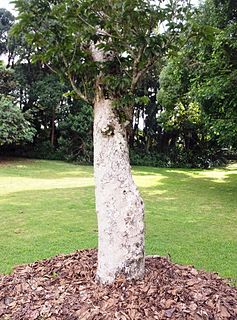Canarium luzonicum, commonly known as elemi, is a tree native to the Philippines. The oleoresin harvested from it is also known as elemi.

Canarium is a genus of about 100 species of tropical and subtropical trees, in the family Burseraceae. They grow naturally across tropical Africa, south and southeast Asia, Indochina, Malesia, Australia and western Pacific Islands; including from southern Nigeria east to Madagascar, Mauritius, Sri Lanka and India; from Burma, Malaysia and Thailand through the Malay Peninsula and Vietnam to south China, Taiwan and the Philippines; through Borneo, Indonesia, Timor and New Guinea, through to the Solomon Islands, Vanuatu, New Caledonia, Fiji, Samoa, Tonga and Palau.

Canarium ovatum, the pili, is a species of tropical tree belonging to the genus Canarium. It is one of approximately 600 species in the family Burseraceae. C. ovatum are native to the Philippines. They are commercially cultivated in the Philippines for their edible nuts and is believed to be indigenous to that country. The fruit and tree are often vulgarized with the umbrella term of "Java almond" which mixes multiple species of the same genus, Canarium.

Canarium asperum is a species of plant in the family Burseraceae. It is found in Brunei, Indonesia (Java), Malaysia, Papua New Guinea, the Philippines, and the Solomon Islands.
Canarium fuscocalycinum is a tree of Borneo in the incense tree family Burseraceae. The specific epithet fuscocalycinum is from the Latin meaning "dark calyx".
Canarium kipella is a species of plant in the Burseraceae family. It is endemic to Java in Indonesia. It is an endangered species threatened by habitat loss.
Canarium liguliferum is a species of plant in the Burseraceae family. It is endemic to the Solomon Islands.
Canarium littorale is a tree found in tropical Asia and is a member of the incense tree family Burseraceae. The specific epithet littorale is from the Latin meaning "of the seashore", referring to its habitat.

Canarium paniculatum is a species of flowering plant in the family Burseraceae. It is endemic to Mauritius.
Canarium patentinervium is a tree of tropical Asia in the incense tree family Burseraceae. The specific epithet patentinervium is from the Latin meaning "spreading nerves", referring to the leaf veins.
Canarium perlisanum is a species of plant in the Burseraceae family. It is a tree endemic to Peninsular Malaysia. It is threatened by habitat loss.
Canarium pseudodecumanum is a tree of tropical Asia in the incense tree family Burseraceae. The specific epithet pseudodecumanum is from the Latin meaning "false decumanum", referring to the species' resemblance to Canarium decumanum.
Canarium pseudopatentinervium is a plant in the incense tree family Burseraceae. The specific epithet pseudopatentinervium is from the Latin meaning "false patentinervium", referring to the species' resemblance to Canarium patentinervium.
Canarium pseudopimela is a tree of Borneo in the incense tree family Burseraceae. The specific epithet pseudopimela is from the Latin meaning "false pimela", referring to the species' resemblance to Canarium pimela.
Canarium reniforme is a species of plant in the Burseraceae family. It is a tree endemic to Peninsular Malaysia. It is threatened by habitat loss.
Canarium sarawakanum is a tree of Borneo in the incense tree family Burseraceae. The specific epithet sarawakanum is from the Latin, referring to the species being native to Sarawak.
Canarium whitei is a species of plant in the Burseraceae family. It is endemic to New Caledonia.

Canarium zeylanicum is a species of flowering plant in the frankincense family, Burseraceae, that is endemic to Sri Lanka. Canarium zeylanicum is a large branched tree that can grow up to 25–30m in height. The seeds of this plant are large, oval, and they can be eaten. This plant can be seen with fruits and flowers in the months of April to September. The oil of the seeds of Canarium zeylanicum are edible and this oil has been used by Sri Lankans for medicinal purposes and for food for ages. However, these uses of the plant are confined to its rural population and even then, they mostly use it for traditional medicinal purposes. Over 95% of the seeds produced and harvested from these plants are thrown away, wasting its source of valuable, natural, and nutritional value.

Laevistrombus canarium is a species of edible sea snail, a marine gastropod mollusc in the family Strombidae. Known from illustrations in books dating from the late 17th century, L. canarium is an Indo-Pacific species occurring from India and Sri Lanka to Melanesia, Australia and southern Japan. The shell of adult individuals is coloured from light yellowish-brown to golden to grey. It has a characteristic inflated body whorl, a flared, thick outer lip, and a shallow stromboid notch. The shell is valued as an ornament, and because it is heavy and compact, it is also often used as a sinker for fishing nets.
Canarium vitiense is a rainforest tree species, of the plant family Burseraceae, growing naturally in Fiji, the Solomon Islands, Samoa, Tonga, New Guinea, Bismarck Archipelago, Admiralty Islands, Louisiade Archipelago, Torres Strait Islands and in lowland north-eastern Queensland, Australia.






